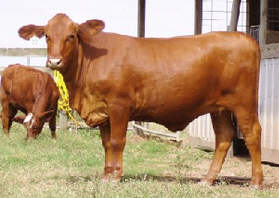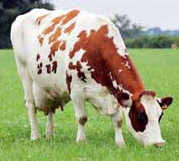



Beefmaster
History
Beefmaster cattle are the first American composite breed (combination of three or more breeds). These cattle have been developed by the Lasater Ranch then headquartered in Texas. The breeding program leading to their establishment was started by Ed C. Lasater in 1908, when he purchased Brahman bulls to use on his commercial herd of Hereford and Shorthorn cattle (Beefmaster cattle are 50% Brahman, 25% Hereford, and 25% Milking Shorthorn).
The first of these bulls that he used were principally of Gir breeding, although some of the Nelore breed were also used. In 1925 he introduced Guzerat blood into the herd.
Mr. Lasater also developed a registered Hereford herd in which the cattle had red circles around each eye. In both his Brahman and Hereford breeding, milk production was stressed. Following his death in 1930, the breeding operations came under the direction of his son, Tom Lasater, who began to combine the breeding of the Brahman and Hereford cattle and also used some registered Shorthorn bulls. After making crosses of Brahman-Hereford and Brahman-Shorthorn, he felt a superior animal had been produced and called the cattle Beefmaster. The exact pedigree of the foundation cattle was not known. The breeding operations were carried on in multiple-sire herds and rigid culling was practiced. The Lasater Ranch estimates that modern Beefmaster have slightly less than one-half Brahman blood and slightly more than one-fourth of Hereford and Shorthorn breeding.
The cattle were handled under range conditions that were often adverse, and a culling program was started based on disposition, fertility, weight, conformation, hardiness and milk production. Stress was placed on the production of beef. No selection has been made to characteristics that do not affect the carcass, such as horns, hide or colour.
The Lasater Ranch breeding program provided an interesting example of the use of mass selection in reaching a goal. Critics should recall that other breeds have been established in a similar way - a blending of breeding followed by selection for economically important points uniformity in many breeds has been achieved only after many generations of selection.
The original concepts of Tom Lasater in developing Beefmaster cattle have continued. Selection continues for those points which were originally used by Mr Lasater and are now known as the Six Essentials - Weight, Conformation, Milking Ability, Fertility, Hardiness and Disposition. Considerable progress has been made in selecting cattle that give very satisfactory levels of production under the practical and often severe range conditions. Satisfaction by ranchers and creditable performance in feedlots indicate the value of stressing the important utilitarian points in developing breeding herds.
The Beefmaster is now the fourth largest beef breed in the US and were recognized by the U.S. Department of Agriculture as a pure breed in 1954.
Characteristics
The breed is recognised as a "Dual Purpose" breed, meaning Beefmasters blend strong maternal traits with excellent growth and carcass abilities. The cattle are heat, drought and insect resistant. They are moderate in size, and while there is no set colour pattern in the breed, they are generally light red to dark red and some will have white mottle on their faces.
The females are excellent mothers, raising a heavy calf each year, and the bulls are aggressive breeders. Beefmasters are intelligent, gentle cattle that are truly a pleasure to work with.
The thing that probably most differentiates Beefmaster cattle from other breeds is the Six Essentials, which were the founding selection principles on which the breed was formed: Disposition, Fertility, Weight, Conformation, Hardiness and Milk Production. Lasater's concept was that you select for cattle only based on these six traits of economic relevance, to the exclusion of many traits that other breeds have expended genetic energy on like colour pattern, horns, height, etc. This unique approach is why Beefmasters are known by the slogan "The Profit Breed."
Statistics
Beefmasters are developed to fulfill the six essentials:-

Photo courtesy of Diamond J Farm Beefmasters www.diamondjfarms.com |
- Fertility
- Milking ability
- Weight
- Conformation
- Hardiness
- Dispostion
You can expect minimal calving problems, heavy weaning weights, exceptionally few health problems, and high fertility from females and bulls. While the breed was created to withstand the Gulf Coast heat and diseases, Tom Lasater moved the foundation herd to Matheson, Colorado in the 1950s, where the winters can be severe. Beefmasters can take heat and cold. Furthermore, their heat tolerance causes many cattlemen to comment that while their other cattle are standing in ponds or lying under shade trees, Beefmasters will be grazing. Beefmaster bulls have few equals when asked to service cows grazing endophyte-infected fescue in hot weather. Likewise, their heat tolerance makes Beefmaster cows more likely to settle in extremely hot weather, especially when grazing fescue. In addition, pinkeye is extremely rare for Beefmaster cattle. No breed offers greater hardiness, fertility, and milk under a wider range of conditions.
Distribution
Although this breed is relatively new compared to many other breed they are popular across the US and can be found in South Africa and Brazil.
References (the above information was cited from the following sites)
(Headline photo courtesy of CBS Ranch www.cbsranch.com


